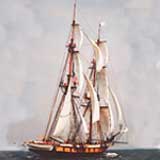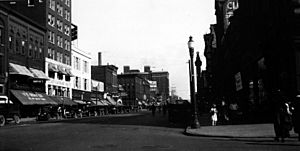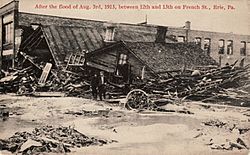History of Erie, Pennsylvania facts for kids
Erie, Pennsylvania, has a long and interesting history as an important city in the Great Lakes area of the United States.
Contents
Native American History
Long before European settlers arrived, the lands that are now Erie were home to Native American groups. The powerful Iroquois Nations and the Seneca Nation lived here. To learn more about the Native Americans who lived in this area, you can read about the Erie Indians.
French Beginnings
In 1753, the French built Fort Presque Isle close to where Erie is today. They built this fort to protect their lands in New France from the English. The name "Presque-isle" is French for "almost an island," and it describes the piece of land that sticks out into Lake Erie, which is now called Presque Isle State Park. The French left the fort in 1760, and the British took it over that same year. This happened three years before the end of the Seven Years' War in 1763.
The Erie Triangle Land
The area where Erie is located was once part of a disputed piece of land called the Erie Triangle. Several states, including New York, Pennsylvania, Connecticut, and Massachusetts, all claimed this land.
On March 3, 1792, the Erie Triangle officially became part of Pennsylvania. This happened after Connecticut, Massachusetts, and New York gave up their claims to the United States government. The government then sold the land to Pennsylvania. The Iroquois Nations also gave up their land claims to Pennsylvania in 1789. The Seneca Nation settled their land claims with Pennsylvania in 1791.
Early Settlers and City Growth
In 1795, Pennsylvania decided to survey the land near Presque Isle. Andrew Ellicott, a famous surveyor who also worked on Washington, D.C., arrived to start this work in June 1795. People began to settle in the area that same year.
Colonel Seth Reed and his family were the first European settlers in Erie. They moved here in 1795 and built a log cabin near Mill Creek. This cabin was the first permanent building in Erie.
Erie officially became a borough (a type of town) on March 29, 1805. It was governed by a council and a burgess. Later, on April 14, 1851, Erie became a city, and a mayor and council were put in charge.
Erie's Role in the War of 1812

During the War of 1812, President James Madison ordered a naval fleet to be built in Erie. This was done to help the United States gain control of Lake Erie. Shipbuilders like Daniel Dobbins from Erie and Noah Brown from New York helped build several gunboats and two larger ships called brigs.
Commodore Oliver Hazard Perry came to Erie to lead this fleet. His ships successfully fought the British in the famous Battle of Lake Erie. This was a very important victory that helped the United States control the Great Lakes.
The Erie Gauge War
In the mid-1800s, Erie was a key railroad center. Different railroads used different track sizes, meaning trains had to stop in Erie to unload and reload passengers and goods. This created many jobs for local people.
However, when a national standard track size was suggested, these jobs and Erie's importance as a rail hub were at risk. The citizens of Erie, led by their mayor, protested strongly. They even set fire to bridges and pulled up tracks to stop the standardization. This event is known as the Erie Gauge War.
{{wide image|Erie PA Panorama c1912 LOC 6a14402u.jpg|880px|A 1912 panorama of downtown Erie.]]
The Prohibition Era
During the Prohibition Era in the 1920s, a law made it illegal to make, sell, or transport alcoholic drinks in the United States. Even though some local leaders supported this law, Erie was mostly a "wet" city, meaning many people did not agree with Prohibition.
Because Erie was a border town on Lake Erie, it became an important place for moving illegal goods across the lake from Canada. Many people in Erie had large amounts of drinks stored away. Secret clubs and places called "speakeasies" opened all over the city where people could gather.
The Great Depression and Change
The Great Depression, a time of severe economic hardship in the 1930s, changed people's views in Erie. Many citizens began to support ending Prohibition. Local political leaders worked to gather support for candidates who promised to repeal the law.
Recent City Improvements
In 2007, a plan was created to improve downtown Erie. This plan included building new structures for homes and shops in the city center. Also in 2007, a company announced it would move, making valuable land available near the Convention Center. Many local citizens hoped this area would become a park or new shops.



